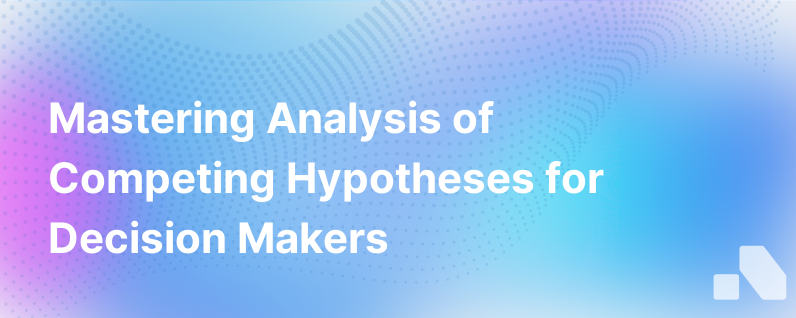Analysis Of Competing Hypotheses
Published on October 24, 2023 by Sawyer Middeleer
In the world of decision-making, failure often results from inadequate evaluation of alternatives and being locked into a favorable hypothesis. It's a problem as old as time, and it often leads to disastrous decisions. One way to overcome these issues is through Analysis of Competing Hypotheses (ACH), a structured analytical technique that helps you objectively evaluate multiple competing hypotheses while minimizing cognitive bias.
In this article, we delve into the concept of ACH and its role in making better-informed and insightful decisions.
Understanding Analysis of Competing Hypotheses (ACH)
Introduced by Richards Heuer of the Central Intelligence Agency (CIA), Analysis of Competing Hypotheses is a systematic method for evaluating ambiguity and uncertainty. In simple terms, it helps assess different hypotheses that could explain observed data.
The key purpose of ACH is to compel an analyst to deliberately disprove hypotheses. Rather than looking for evidence that supports a favored hypothesis, ACH pushes you to discover evidence inconsistent with potential hypotheses. This method proves vital in psychiatry, criminal investigations, intelligence analysis, strategic planning, or any domain where potential ambiguity exists.
ACH can save you from falling into the pitfall of cognitive biases – the common tendencies to favor information supporting our preconceptions and to ignore inconsistent evidence, otherwise known as confirmation bias.
The ACH Process
The framework of Analysis of Competing Hypotheses comprises eight steps. Taken together, they form an iterative approach that requires returning to previous steps as new information emerges or as hypotheses are redefined:
-
Identify Potential Hypotheses: Begin by brainstorming all plausible hypotheses. They should be mutually exclusive, and valid in the sense that they could explain the observed data.
-
Collect Evidence: Next, gather all the significant evidence and arguments related to the hypotheses. This could be data, assumptions, observations, or expert judgments.
-
Prepare Matrix: The third step is to establish a matrix of hypotheses against evidence. Each row represents an item of evidence or argument, and each column represents a hypothesis.
-
Evaluate Evidence and Arguments: Every piece of evidence should be evaluated against every hypothesis. The matrix is filled by noting whether the evidence is consistent, inconsistent, or not applicable to each hypothesis.
-
Refute Hypotheses: This is the most crucial step contrast to other decision-making Models. Rather than seeking evidence to support a hypothesis, here, we seek facts that refute.
-
Evaluate the "Diagnosticity" of the Evidence: Determining the “diagnosticity” of your evidence is the ability of that evidence to determine the accuracy of the hypothesis.
-
Hypotheses Score: At the end of this iteration, each hypothesis carries a score. The one with the least evidence against it (not the most supporting it) is the most likely hypothesis.
-
Review and Monitor Conclusions: Determining the best hypothesis is not the end of the process. It’s important to assess the vulnerability of the chosen hypothesis to key evidence or assumptions.
Advantages & Disadvantages of ACH
Advantages
- It deliberately avoids cognitive biases by seeking disconfirmation of hypotheses rather than their confirmation.
- It encourages the consideration of multiple hypotheses, which compromises premature cognitive closure.
- It uses a systematic and transparent process that leads to robust and empirically supported conclusions.
Disadvantages
- The ACH process is time-consuming and may not be applicable in all situations, particularly where time is a restriction.
- It does not automatically take into account the severity of the consequences arising from being incorrect. In certain scenarios, the ramifications of an incorrect hypothesis might suggest a more cautious approach.
- The system isn't perfect and can complicate the decision-making process if applied inappropriately.
Conclusion
With the rise of artificial intelligence and Big Data, there is an urgent need to systematize decision making. The ACH approach, despite not being a one-size-fits-all solution, remains invaluable in this context. It encourages the consideration of various hypotheses and contributes to a more open-minded and holistic investigation process. Tools like Aomni provide crucial support here, offering real-time insights that analyze competing hypotheses to enhance decision-making efficiency and reliability. Whether used by intelligence analysts or business decision-makers, the ACH method can significantly improve the quality and objectivity of your analyses.